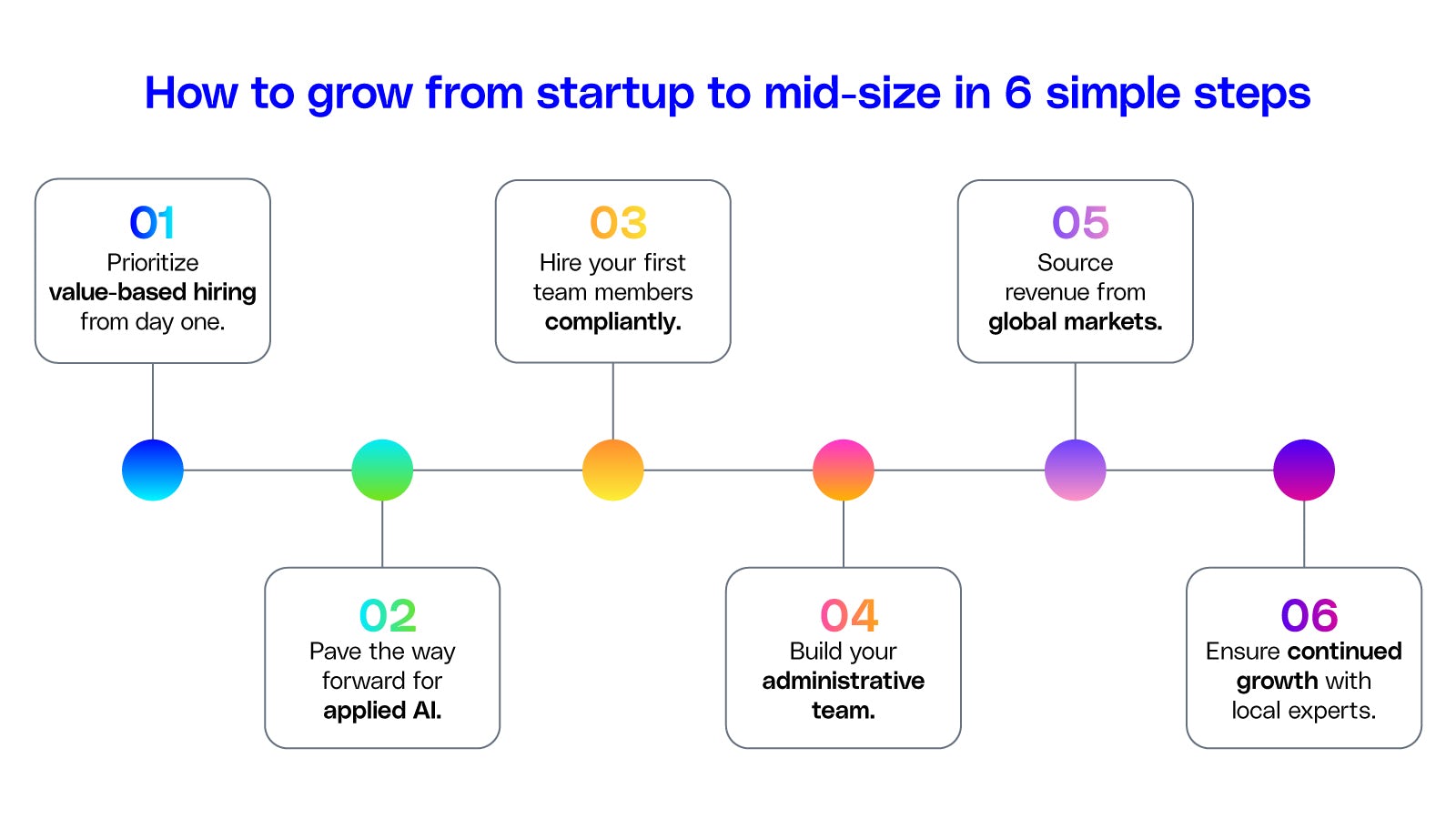Establishing a new market entry strategy is a natural next step for leaders in a fast-growing business. You believe in your product and services, you’ve hired a team of superstars, you’ve proven your value in the marketplace, and you’ve established partnerships that show you’re not alone in this belief. Now, it’s time to consider unlocking new opportunities by expanding your business to new markets.
What is a market entry strategy? Market entry involves entering markets with an existing product or service. A strong market entry strategy outlines essential specifics on how to grow your business. A well-established strategy should also highlight business goals, an overview of the target market, sales goals, and a go-to-market plan on how you’ll drive ROI.
The next step? Share your company’s vision and product far and wide. Whether you’re a business with 10 employees or working from your kitchen table, all startups are built on promise — and can develop into valuable entities with the right plan in place.
While your company is growing, it can also be a daunting task to transition from startup to mid-sized company. When you embark on a new market entry project, use this multi-step blueprint to build your go-to-market plan and accelerate value faster.
Growth vs. scale: What does it mean to scale a startup?
A common thread across all startups is walking the line between growth and scaling. Growth involves expansion and an increase in various aspects of the business, while scaling is more about optimizing operations to handle growth more efficiently.
As you seek to expand your early stage startup into a mid-size business, growth may require a proportional increase in resources. Scaling, on the other hand, aims to achieve more output with the same (or even fewer) resources. From hiring more employees to expanding into new markets, growth manifests by expanding a company’s operations, customer base, and global market presence. While achieving growth may seem daunting in today’s complex market ecosystem, successful market entry is possible with a long-term business model that is built to grow rapidly.
How to create a winning market entry strategy
When entering a new market, it’s essential to invest in capabilities to manage and spur growth, especially in often overlooked areas such as administrative tasks and human resources functions.
For businesses of all sizes, a new market entry strategy should include these common steps:
- Research the target market. Understanding the market size, competitors, customer needs, and regulatory requirements is an important starting place to ensure your company’s unique value prop is a fit.
- Define clear goals and objectives from the onset. Your target market analysis will inform your goals and objectives. Create precise and realistic business goals based on your company’s target growth KPIs.
- Determine your mode of entry. Your research and goals help in selecting how you enter the market. From exporting to partnering, how you choose to launch your business operations in your target market should be based on steps 1 and 2.
- Map your strategy to your financial needs. Success is built on the numbers. Ensure you have the right allocation of both financial and talent resources to meet your goals.
- Document, monitor, and assess performance. Keep organized documentation of your research, goals, and processes. Having this information on hand makes required adjustments identified in the monitoring and assessment process easier. Don’t forget to look back to move ahead.
How to grow from startup to mid-size in 6 simple steps
While there is no “one-size-fits-all” approach to running your own growth, startups embarking on a new market entry project should prioritize value-based hiring, focus on a global growth mindset, and give new hires a competitive advantage in a local market. And by engaging with an Employer of Record partner like G-P to help you, you’ll find that you can put your plans for growth into motion with more flexibility and efficiency than ever before.

You can reinvigorate your company while expanding your team, product, or service offerings. Here’s how we recommend doing just that:
1. Prioritize value-based hiring from day one.
As you expand your marketing efforts as a business owner, chances are you’ll need to grow your team. With 77% of workers considering a company’s culture before applying for a job, it is key to focus on fostering a positive and inclusive work environment that shines through your brand image to position your company as an appealing option to top talent. People are increasingly seeking out a deeper meaning in their work, and startups are uniquely positioned to attract just that: people with a passion for your mission.
Seek out candidates who are drawn to the guiding principles that define your organization and how it operates. According to the Asia Pacific Workforce Hopes and Fears Survey 2023, human skills matter most in the workplace. Employees rank people skills such as adaptability/flexibility (69%), collaborative skills (67%), and critical thinking (66%) above technical or core business skills. Clearly define your unique value proposition in your target market, adapt your interview process to speak openly, and ask behavioral questions that can better evaluate a candidate’s soft skills.
2. Pave the way forward for applied AI.
Any successful business entering a new market should also adopt technology that drastically decreases the administrative burden of manual work. For example, you may want to simplify marketing strategies for your startup or small business by investing in a lead generation tool that automates email creation and deployment.
You can also free up time for product development by leveraging Artificial Intelligence (AI). Have you used ChatGPT to outline business plans, or Dall-E 3 to build a paid social ad? Chances are you’re not alone. According to a recent survey by McKinsey & Company, the average number of AI capabilities companies used was 3.8 in 2022 (including computer vision and natural-language generation), double the 1.9 used in 2018. AI can strengthen your talent pipeline, improve ways of working for existing talent, and scout new job seekers as you build out your joint venture.
New features and technology offered within G-P’s suite of global employment products also provide everything you need – including intuitive self-service and AI-enabled features – to streamline the administrative and legal complexities of global business expansion and new market entry, so you can focus on building your teams.
3. Hire your first team members compliantly.
Your first hires in a new country are critical to success during expansion. You need someone with local knowledge, a passion for your company’s mission, and the ability to build and coach an entirely new team.
To get started, it’s important to understand the local talent market, including any benefits or perks that professionals in the area tend to prioritize during their job search. Then, leverage these key insights to attract top talent via job listings, during the interview process, and through referrals.
It’s also crucial to familiarize yourself with the local employment laws and regulations. For example, some countries have significant limitations around background checks while others are less stringent with the information companies can inquire about. Similarly, employment contract requirements vary by country and can lead to serious problems down the road if they’re not followed.
4. Build your administrative team.
Once you’ve chosen the perfect candidates for the job, most companies need to contract support personnel, human capital management technology, internet providers, and other services for their teams. You will need to set up financial controls and an expense system. The new hires may expense equipment, networking, travel, local suppliers, and interviewing costs as they begin building their teams.
Here’s why you need to trust your first hires implicitly: Real team players can inform on the best workspaces, service providers, and expense needs for their markets.
5. Source revenue from global markets.
If you laid firm groundwork for your new market teams, they’ll be eager to get down to business, bring in clients, set up local partnerships to attract potential customers, and most importantly, generate cash flow. Repatriating international profits safely and quickly to your local currency is crucial, but you’ll also want to secure the best rates on transfers, so your ROI doesn’t dwindle due to uncompetitive exchange rates and high bank fees.
Setting up a business bank account abroad and having paid-up capital of about USD 100,000 (which is a necessity for many banks) often requires executives to make in-person visits to the country. Time and travel restrictions may simply make this an impossibility. A sound option is to open a multi-currency account, which saves companies time, administrative hassles, and cost while offering better exchange rates than any bank.
6. Ensure continued growth with local experts.
If all goes well, your first hires will need to build a team quickly. Since new hires are entrepreneurs at heart, they’ll be looking for the next big challenge once the local team is settled in. To ensure employees maintain their momentum, it’s key to equip them with the proper support and expertise and prevent common growth obstacles from slowing them down.
Leverage the knowledge of in-country experts to free up valuable team members’ time. Local experts can handle the complexities surrounding onboarding, taxes, compliance, and intellectual property while your global team focuses on successfully scaling your company.
That’s where G-P comes in. Our in-region HR and legal experts have over a decade of experience helping companies at all stages build and manage global teams, anywhere in the world – starting in just minutes. As your guide to global growth, we handle the legal and administrative tasks that often get in the way of seamless market entry.
Grow your startup with G-P.
Explore our Top Business and Workplace Trends for 2024 to start embracing the global growth mindset and working towards your expansion goals. Our Global Growth Platform™ offers everything your startup needs to rapidly find, hire, and manage global teams in 180+ countries. Transitioning from a startup to a mid-size business is not without challenges, but with G-P by your side, the new market entry that comes with this kind of growth can be faster and easier than you ever imagined.




